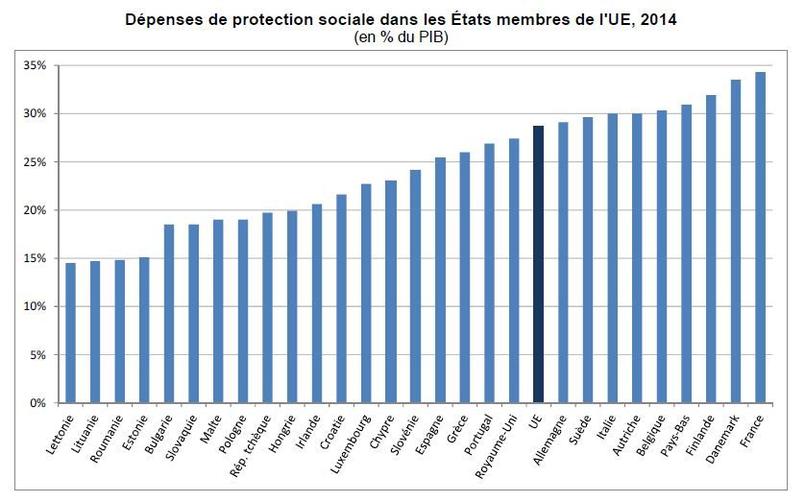According to the statistical office of the european Union, the social protection expenditure in our countries accounted for 34.3% of GDP, the highest ratio in the european Union.
Since 2011, social protection expenditure increased by 0.4 percentage point in the european Union (EU), from 28.3% of GDP in 2011 to 28.7% in 2014, according to a note from Eurostat, the statistical office of the european Union, published on Wednesday 21 December.
In 2014, the two main sources of funding are “the government contributions from taxes (counting for 40% of total revenue), and social security contributions for 54%,” observes Eurostat.
The share of GDP devoted to social protection differs from one member State to another. In 2014, these expenditures accounted for over one-third of the GDP in France (34,3%), which holds the european record! This ratio amounted to 30.3% in Belgium, 30% in Italy, to 27.4% in the United Kingdom, or 29.1% in Germany. In contrast, social protection expenditure were below 20% of GDP in Latvia, Lithuania, Romania, Estonia, Bulgaria and Slovakia.

These variations reflect differences in levels of life, but also illustrate the diversity of national social protection systems, demographic structures, economic, social, and institutional-specific to each member State.But they also correspond to political choices.
When one looks at the expenditure on social protection per capita in 2014, expressed in purchasing power standard – a unit of artificial currency to purchase the same volume of goods and services in all countries, the highest per capita expenditures are observed in Luxembourg, Denmark, the netherlands and Austria to around 35% to 40% above the EU average, followed by Germany and France (about 30% above the average). The per capita expenditure of the lowest was recorded in Romania, over 70% below the EU average.
*although Iceland, Norway and Switzerland are not part of the EU, these countries are integrated in the following charts for comparison.
But look more closely at what constitutes the main social protection expenditure in almost every member State. First of all, the old-age and survival (including pension reversions). On average in the EU, the pensions of old-age and survivors accounted for 45.9% of total social benefits in 2014, is the most important part of social spending. This share was highest in Greece (65%), Poland (60.4 per cent), Italy (58.6 per cent), while it was lowest in Ireland (29.8 per cent), Luxembourg (37.7 per cent), Germany (39.2%) and in Belgium (40.3 per cent). In France, this share amounted to 45.4%. It represents the largest share of expenditure on social protection in France.
The benefits of illness, health care and disability benefits accounted in 2014 for 36.5% of total social benefits in the EU. But for Ireland (40.6 per cent), Germany (42.8%) and Croatia (45.8 percent), it is the largest item of expenditure in social protection. In France, this post reached 35% of total spending in social protection and in the United Kingdom, 37.2 per cent.
on average in the EU in 2014, family benefits accounted for 8.5% of total social benefits. The share of family benefits ranged from 3.1% in the netherlands to 15.6% in Luxembourg. France is below the average with 7.8%, while the share devoted to the family and children in Germany (11.3%) and the Uk (10.4 per cent) is higher. In contrast, in Southern countries such as Italy, Spain or Greece, the share devoted to the family is even more low.
with Regard to unemployment benefits, the ratio in the EU amounted to 5.1%. The share of unemployment benefits ranged from 1% of the total in Romania, 13.8% in Ireland. In France, it is 6.2%, Germany 3.9% and in the Uk 1.7%.
Finally, the share of services related to housing and the social exclusion extends to between 0.2% in Greece and 7.7% in the United Kingdom. The ratio in France amounted to 5.5%, Germany 2.8%, and Uk 7.7%.
No comments:
Post a Comment